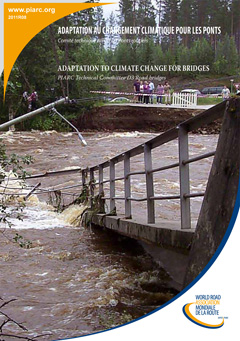Adaptation to climate change for bridges

Climate change has now become a global issue of concern and it is for this reason that the World Road Association has incorporated it into the strategic themes for the term 2008-2011. Higher levels of carbon-dioxide as part of greenhouse gas emissions are being released resulting in heat being trapped in the atmosphere, which over time will result in a rise in the earth's air temperature. This rise in temperature will filter into the oceans causing sea water to expand and therefore raise sea levels. There are already signs of extreme weather occurring in certain parts of the world resulting in events like drought, heavy rainfall, flooding, typhoons and violent storms and in addition landslides, rock falls, mudflows, avalanches and glacier melting. The frequencies of some of these events are also increasing.
At the Copenhagen Summit held in December 2009, a global agreement on climate change could not be reached and therefore it is most likely the current carbon-dioxide emissions will continue. Under Strategic Theme D (Quality of Road Infrastructure), issues of concern of the extreme weather impacting on design and management on assets are being addressed. With regard to road bridges, of concern are the extreme day and night air temperatures causing expansion and contraction of bridge superstructures, frequency and intensity of rainfall (causing major flooding). Therefore there is a need to review existing design codes about flood return periods, extreme wind patterns that effect the design return periods, intensity and frequency of earthquakes with the secondary effects as landslides or tsunamis. Scour control is also another aspect that needs consideration.
Thirteen countries or states from five continents responded to this study, whose networks range from a few hundred kilometres to tens of thousands of kilometres and with substantial number of bridges. In general, there are extreme natural events being experienced in many countries resulting in loss of lives and loss or damage to infrastructure. Importantly however, most countries cannot qualify that these events are as a result of climate change.
The committee recommends to study, in the future, any provisions made by countries in the planning and implementation phases of projects to consider limiting a project's impact to climate change, particularly in bridge design and construction.
Information sheet
- Date: 2011
- Author(s): Comité technique D.3 Ponts routiers / Technical Committee D.3 Road bridges
- Domain(s): Environment / Road Bridges / General
- PIARC Ref.: 2011R08EN
- ISBN: 2-84060-241-5
- Number of pages: 68